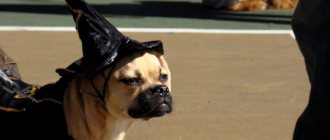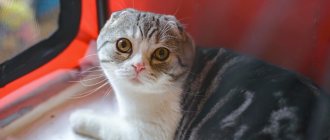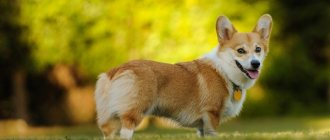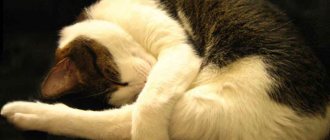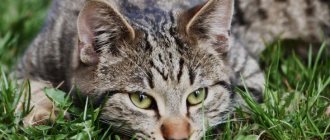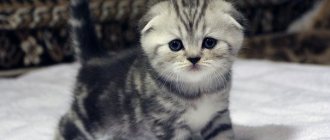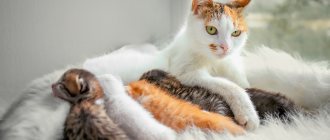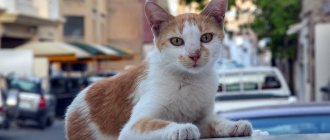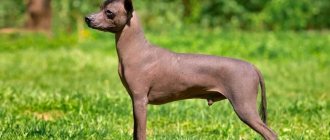Brief history of the breed
The homeland of the Scottish Straight is Scotland, and the ancestor is considered to be a cat named Susie, who had unusual folded ears. Breeders tried their best to fix the mutational gene for lop ears in the breed. And to give a pretty appearance, they additionally used Persians, Burmese, British and American Shorthairs. As a result, the efforts of the breeders were crowned with success, and a fold-eared cat with a round head and large eyes was born. The breed was called the Scottish Fold and quickly gained popularity.
True, it soon became clear that when two lop-eared individuals are crossed, sick offspring are born. To improve health, folds began to be mated with straight-eared cats. In the litters from such “marriages” there were approximately the same number of fold-eared and straight-eared kittens. Despite the minimal differences in appearance, the latter have long remained without due attention from professionals. But in 2004, Scottish Straights received WCF recognition and the status of a separate breed. At the same time, a ban was imposed on the crossing of Scottish Straights with the British. It is believed that such cross-breedings cause deterioration in the external characteristics of each of these breeds.
What to feed a Scottish kitten
Food for Scottish fold and straight-eared kittens is selected depending on age. The food is balanced, high in calories, and high in protein.
When eating at home, a diet is made from natural products with a high-quality selection and the right combination of ingredients.
Up to 2-3 weeks until the kittens open their eyes well, begin to run independently, and feed exclusively on the milk of the mother cat. Then they are fed by carefully introducing natural products into the food in liquid crushed form. They are taught to eat raw, well-frozen, finely chopped meat to prevent infection with worms. Be sure to include vegetables and fermented milk products in your daily food.
When they decide to feed their pet commercial ready-made food, dry or jelly-like, they choose manufacturers with high-quality premium products with a line “from 1 to 12 months” specially balanced for feeding kittens. Such complexes contain sufficient amounts of protein, carbohydrates, vitamins and minerals for the kitten’s growing body.
Important! During the period of breastfeeding, it is necessary to intensively feed the mother cat, whose body is severely depleted by childbirth, and intensive feeding of kittens.
1 month
The Scottish kitten is 1 month old, and additional nutrition is gradually being introduced along with mother's milk. All new food should be soft, diluted with milk. From this age, the kitten can be given clean bottled water, which is poured into a separate bowl and changed regularly, once a day.
Table No. 1. The diet of a one-month-old kitten may consist of:
Weaning food stored in the refrigerator is warmed to room temperature. At the age of one month they switch to feeding Scottish kittens 8 times a day.
2 month
A Scottish kitten that has grown up to 2 months becomes frisky and playful. His first teeth appear. For the proper development of an active, growing Scot, a higher calorie diet is required. Chicken yolk mixed with minced meat is added to maternal nutrition and daily complementary feeding products. Switch to raw, pureed vegetables and fruits. The total volume of food is 120 grams, including breast milk. Gradually, the kitten is separated from its mother, reducing breastfeeding.
Two-month-old kittens can be gradually transferred to industrial food. The food is purchased from a high premium class, balanced with the age of the kitten. Dry food is soaked in milk or water; soft food is better processed by the stomach. It is more advisable to feed a kitten with wet canned food, enriched with vitamins in accordance with the age of the kittens.
3 month
A three-month-old kitten, already completely switched to food, is given to another family for upbringing and a place to live. When a purebred Scottish kitten is sold, the owner is given a fully completed certificate (passport), which indicates all vaccinations received against feline infections with the date of revaccination.
The new owner receives advice from the breeder on what to feed a Scottish kitten at 3 months. A sudden change in a kitten’s diet affects the functioning of the digestive system and can lead to diarrhea and vomiting.
At home, the pet is transferred to 6 meals a day with an increased amount of food up to 180 grams. Dry food is not soaked, meat is given in pieces; kittens at this age have already fully formed dentition.
Meat products are mixed with pureed raw vegetables with the addition of bran from various cereals. Porridge cooked in water is introduced into the diet, also in combination with meat and vegetables.
After 3 months, a Scottish kitten can be completely switched to industrial high-quality, premium food, taking into account the age category.
4 month
At 4 months, Scottish kittens already look like their breed: fold-eared or straight-eared. The animals are fed 4-5 times a day, but more intensively, bringing the amount of food to 240 grams per day.
The diet remains the same in terms of food composition, so what to feed the Scotsman is a resolved issue; there is no need to come up with something new. The pet’s gastrointestinal tract is fully formed, the proportion of meat (beef, poultry, rabbit) is increased, with larger cuts, so that the jaw develops and the teeth are sharpened. The recommended amount of meat is 160 grams per day. Mineral and vitamin complexes purchased at a veterinary pharmacy are added to the porridge with pieces of vegetables.
For kittens transferred to industrial food, it is better to purchase ready-made dry and wet food products from one manufacturer with a diverse line of composition according to the age of the kittens.
Scottish kitten weight by month
When keeping a Scottish kitten, it is important not only proper care and a rationally formulated diet, but also control over maintaining weight within acceptable limits, especially in a newborn kitten up to one year old.
The size and weight of a Scottish fold and straight-eared kitten depends on:
After birth, babies develop quickly but unevenly. Body weight and weight up to 5 months in Scottish Straight and Fold kittens develops rapidly, but then the growth rate decreases.
Weight and height are influenced by the diet of the mother cat and additional feeding of the babies. At 5 months, the weight of a boy's Scottish kitten can reach from 2.6 to 4.3 kg and he looks well-formed and nimble.
Much depends on how the mother cat's pregnancy proceeded. With proper nutrition, healthy offspring appear in the litter.
The rate of growth and weight depends on the sex of the Scot; cats are always larger than female cats.
The appearance is influenced by the genetic characteristics of the parents; a large species of cat and female cat give birth to the same kittens.
Table No2. Weight of a Scottish kitten by age from birth to one year.
Interesting Facts
During the existence of the Scottish Straight breed, many interesting things have been associated with it:
- Scottish Fold and Scottish Straight are closely related breeds. The difference between them is the shape of the ears.
- The name of the breed reflects its appearance. It consists of two English words scottish - Scottish and straight - straight.
- To obtain healthy offspring, straight-eared Scottish cats are bred only with fold-eared cats. And Scottish Straight females are crossed exclusively with Fold males.
- Unlike many other straight-eared cats, Scottish Straights have softer and thinner cartilages. This feature is explained by the presence of a mutation gene. It is because of this that kittens of this breed are born with drooping ears, which later become straight.
- The Scottish Straight has a funny habit: the Scottish Straight can sit for a long time on its hind legs, folding its front legs on its chest.
Breed description, standards, appearance
Scottish Straight cats are flexible cats with straight ears, a rounded, well-proportioned body and soft plush fur. Scots have characteristic features that make them easy to distinguish from other breeds.
Dimensions and weight
Scottish Straight cats are not large in size. The average weight of an adult male is 5-6 kg. A female Scottish Straight weighs between 3-5 kg.
Anatomical characteristics
A classic representative of the Scottish Straight cat breed must meet the following description:
Color and coat type
The Scottish Straight is a short-haired cat with a dense, silky down that feels like plush.
The Scottish Straight standard allows for the existence of any colors. But most often the following color options are found in the breed:
Possible breed defects
Flaws in appearance, in the presence of which a Scottish Straight cat will not receive a high expert assessment:
Description of the breed's appearance
Now you can smoothly move on to describing the appearance of the Scot:
- The body is of medium size and moderate length. We can definitely say that large size is not about Scottish. Their weight usually does not exceed 4-5 kg for boys and 3-4 kg for girls, that is, the former are always somewhat larger. The height at the withers is in the range of 30-32 cm. A characteristic characteristic of adult individuals is well-developed muscles. The body length is moderate, the contours are rounded. At the same time, Scottish straights are more elongated and graceful than the British. In other words, a Scottish Straight cat that meets the standard must be well balanced, harmonious, and flexible in its movements.
- The head is of medium size, proportional to the body, resting on a wide, short neck. It has a round shape, the outlines of which form a convex forehead, full cheeks, and a rounded chin. The transition from forehead to nose is not clearly expressed. The eyes are round and widely spaced. As for their color, you should focus on the color of the fur coat.
- Ears – this characteristic of straights is worth mentioning separately, as this is their main external distinguishing feature. The ears, as is clear from the name of the breed, do not tilt forward at all. They are small in size, rounded at the tips. They are not very wide and are open at the base. Spaced quite widely. They are very well pubescent on the outside, and have brushes of hair on the inside.
- The wool is generally well knitted, giving it a feeling of density and plushness. Straights have a very good thick undercoat. The main pile is thin, soft, and does not adhere to the body. But, of course, we should not forget about the Highlands, whose coat is longer and resembles the coat of the Persians. This individual is decorated with a beautiful collar and feathering on the paws between the toes. Despite the luxurious coat of long-haired cats, the cottony effect should not be encountered.
- Speaking of paws. They should be low, but at the same time well standing on the ground. This is extremely important to pay attention to, since an animal with incorrectly positioned limbs can be legally disqualified by show judges.
- Tail – can be medium or long. The latter is still preferable. However, regardless of the length, it should taper evenly towards the tip. Flexibility in all places of the tail must be present. For creases and thickened vertebrae that impede flexibility, the animal will be disqualified. In the Highland Straight this part of the body is also very fluffy.
Character and temperament
The Scottish Straight is a good-natured, moderately active cat with an independent disposition. The Scottish Straight does not like to sit on his hands for a long time and prefers to explore the territory and play outdoor games. Despite his attachment to his owners, the independent nature of the Scottish straight-eared cat does not allow him to be excessively intrusive. The Scottish Straight will always find something to do, especially if there are enough toys.
On a note. Scottish Straight loves privacy. The Scottish Straight does not need constant contact with its owners and is suitable even for those who spend a lot of time outside the home.
The good-natured nature of the Scottish Straight allows him to get along with children without problems. True, the Scottish Straight Dog does not like to be cuddled, and will in every possible way avoid babies who carry her in their arms.
Scottish Straights get along well with other cats and non-aggressive dogs. But the character and habits of a real hunter prevent representatives of the breed from coexisting peacefully with ornamental rodents and birds. Scottish Straights perceive hamsters and other similar animals as prey. Therefore, it is better not to keep them in the same house.
How to choose the right kitten
Before you go for a Scottish Straight kitten, it is advisable to study the breed standard and find contacts of trusted breeders or certified nurseries that specialize in breeding Scottish Straights. You should also make sure in advance that the kids have all the necessary documents confirming their breed and vaccinations.
When meeting kittens, it is important to evaluate the living conditions and behavior of little Scots. Scottish Straight kittens should be active, playful and moderately curious.
The appearance of straight-eared Scots must not only correspond to the breed standard, but also indirectly indicate their state of health.
Kitten care
Until the age of three months, small Scottish Straights live with their mother, and care for them lies with the cat and the breeder. The Scottish Straight is delivered to new owners no earlier than 12 weeks of age. Therefore, future owners have time to prepare for the arrival of their pet. For a Scottish Straight kitten, buy in advance:
- bowls for water and food;
- house or bed;
- scratching post;
- toys;
- grooming tools;
- hygienic cosmetics;
- tray and filler.
On a note. To ensure that the room where the Scottish straight-eared kitten will live is completely safe, small objects, indoor plants, household chemicals and wires are hidden away. And so that the little Scottish Straight does not suffer because of his own curiosity, all windows and doors of large appliances such as ovens and washing machines are closed in the house.
Development of a two month old kitten
Straight-eared and fold-eared “Scots” at 2 months have an average weight:
- cats: 0.4-0.9 kg.
- seals: 0.8-1.7 kg.
The large difference in parameters is easily explained - the indicator depends on a number of factors: genetic predisposition, the quality of feeding of the litter by the mother, the peculiarities of keeping a particular kitten. A slight deviation from the norm is not pathological, but if the kitten has too much or too little weight, it is better to show it to the veterinarian.
By the 2nd month of life, Scottish Folds already have drooping ears - even an inexperienced owner will be able to identify Fold (low-eared) and Straight (straight-eared).
The baby feeds on his own - the cat is gradually offered solid food and meat. He no longer needs round-the-clock maternal supervision - the kitten licks itself and puts itself in order.
By 2 months, the kittens’ “exploratory spirit” awakens—kids can climb into hard-to-reach and sometimes unexpected places. Therefore, a caring owner reliably blocks their access to rooms and corners where children should not be.
The “Scots” are also overtaken by “edible” curiosity – they want to taste literally everything around them. Therefore, babies are kept in an isolated safe space, where there are no plants that are poisonous to cats, sharp, piercing or cutting objects, or fragile and unreliable furnishings.
At 2 months, cultured kittens already know how to use a scratching post and litter box. But, like all kids, they sometimes make mistakes for which it is impossible to scold, let alone punish, a small animal.
The kitten, along with its brothers, begins to be interested in people - it comes up to “get acquainted”, cuddle and play. But you shouldn’t follow the lead of the charming fluffy ball - you need to stop him in attempts to scratch, bite a person, or “attack” an arm or leg. The child is scolded in a stern voice, the game is stopped and ignored for a while.
An important procedure for a two-month-old pet is the first vaccination. The vaccination is a two-stage process - as a rule, the first one is given by the breeder, and the new owner continues the schedule.
Care and maintenance
The Scottish Straight is an exclusively domestic cat that perceives walks not as a necessity of life, but as an interesting adventure. It is unpretentious in everyday life and does not require special conditions. In general, caring for a cat of this breed comes down to basic hygiene and balanced feeding.
Hygiene procedures
In order for the Scottish Straight to have an aesthetic appearance, it is provided with proper care:
Grooming
The Scottish Straight has short fur that does not require daily grooming. In normal times, it is enough to brush your cat a couple of times a week. During the molting period, the procedure is carried out daily to speed up the process.
The Scottish Straight is bathed 3-4 times a year. To do this, the wet cat is washed with a special shampoo for short-haired breeds, and then thoroughly rinsed and dried with a terry towel.
Important. The Scottish Straight is a very clean cat. She often licks her coat, and to remove the fur from her stomach, she needs to be periodically given a special paste.
Tray
Straight-eared Scots quickly learn to go to the toilet in a strictly designated place. It is important that the tray is always clean and in a secluded corner. Its shape doesn't really matter. The main thing is that it is deep enough and has high sides. The filler should be selected taking into account the preferences of the cat itself. After all, if the Scottish Straight doesn’t like him, the Scottish Straight may refuse to relieve himself in the litter box.
Feeding the cat
In order for a Scottish Straight cat to develop properly and remain active for a long time, he is provided with a balanced diet.
Complete diet
The Scottish Straight can eat both dry and natural food. In the first case, the cat is selected high-quality premium or super-premium products, which contain all the necessary substances. Another important characteristic that should not be neglected when choosing drying is the absence of soy, preservatives and dyes. Products from the following brands best meet these criteria:
- Hills;
- Bosch;
- Brit Care;
- Pronature.
With a natural type of nutrition, the Scottish Straight diet is designed so that it contains at least 70-80% meat. In addition, the Scottish Straight must receive:
- porridge with water;
- boiled vegetables;
- offal;
- boiled eggs;
- sour milk;
- lean sea fish.
In order not to shorten the lifespan of the Scottish Straight, he is not given pork, sausages, smoked meats, pastries, sweets and potatoes. Also, the Scottish straight-eared dog should not eat river fish, bones and leftovers from the master's table.
Feeding frequency
A Scottish Straight kitten eats less, but more often than an adult animal. Therefore, when drawing up a feeding schedule, be sure to take into account the age of the Scottish Straight:
- up to 6 months – 4-5 times a day;
- 6-12 months – 3 times a day.
From the age of one year, the Scottish Straight is transferred to twice feeding.
Vitamins and minerals
If the Scottish Straight eats natural products, a deficiency of microelements may occur in its body. To make up for this deficiency, the Scottish Straight is given special feeding courses twice a year. When selecting a vitamin-mineral complex, it is better to rely on the recommendations of a veterinarian who knows the characteristics of a particular cat.
On a note. If the Scottish Straight eats high-quality dry food, it does not need additional feeding.
What to feed a kitten: breakdown by age
If you are feeding a kitten with food, then everything is simple: choose the food in accordance with the age indicated on the package, serve it in the quantity specified in the instructions, and as many times as required by age. But it is worth noting that the food contains many ingredients and if your cat has sensitive digestion and reacts negatively to some components of the food (vomiting, diarrhea), then it is difficult to figure out what kind of product it is. For such cases, natural nutrition is recommended.
Those who are planning to feed their cat natural food will have to study the issue. It will be difficult at first, as you need several meals a day. Once the kitten becomes a teenager, that is, reaches 5 months, everything will become much easier.
Feeding raw meat is preferable for felines because... in nature they feed on it. This diet is considered more balanced, because... Boiled meat already lacks many essential elements. The main thing is that the meat is of high quality, from a factory where infection with worms is minimized and where they are not addicted to chemicals.
A kitten should consume approximately 10% of its body weight per day. This is the average. It is not customary for kittens to limit their food: they should eat as much as they want.
For those who want to feed their cat natural food, but have little time for it, breeders advise making preparations. Mix meat, offal (heart, neck, kidneys - if your cat doesn’t like kidneys because of the specific smell, in which case you can do without kidneys, a little liver - if there is too much liver, the cat may swear), herbs, vegetables (if it contains carrots, its need to be pre-cooked), raw quail egg, chopped kelp or other additive. Place this mixture in portions in bags and freeze in the freezer. Then take out one bag at a time and bring to room temperature. The mix is ready: you can serve the healthy dish to your cat.
Vaccinations and antiparasitic treatment
To prevent the Scottish Straight from becoming infected with a viral or infectious disease, the cat is regularly vaccinated against calcivirosis, panleukopenia and rhinotracheitis. The first vaccination for a small Scottish Straight is given at the age of 7-8 weeks. After 28 days, the animal is vaccinated against the same diseases and against rabies. Subsequently, the Scottish Straight cat is vaccinated annually.
To prevent the development of diseases carried by fleas and worms, the Scottish Straight is systematically subjected to antiparasitic treatment. Scottish straight cats should receive anthelmintic drugs once every six months with mandatory repetition after 10-14 days.
Scottish Straight fleas are treated with special drops or shampoos. And if the Scottish Straight is out for walks, the cat is additionally protected with an anti-parasitic collar.



